Life As a Low Vision Therapist, Orientation and Mobility Specialist, or Vision Rehabilitation Therapist
Vision Therapist or Specialist Job Description Provide therapy to patients with visual impairments to improve their functioning in daily life activities. May train patients in activities such as computer use, communication skills, or home management skills.
List of Vision Therapist or Specialist Job Duties
- Design instructional programs to improve communication, using devices such as slates and styluses, braillers, keyboards, adaptive handwriting devices, talking book machines, digital books, and optical character readers (OCRs).
- Teach clients to travel independently, using a variety of actual or simulated travel situations or exercises.
- Monitor clients’ progress to determine whether changes in rehabilitation plans are needed.
- Train clients to use tactile, auditory, kinesthetic, olfactory, and propioceptive information.
- Train clients to read or write Braille.
- Obtain, distribute, or maintain low vision devices.
Featured schools near , edit
Vision Therapist or Specialist Needed Skills
These are the skills Low Vision Therapists, Orientation and Mobility Specialists, and Vision Rehabilitation Therapists say are the most useful in their careers:
Active Listening: Giving full attention to what other people are saying, taking time to understand the points being made, asking questions as appropriate, and not interrupting at inappropriate times.
Speaking: Talking to others to convey information effectively.
Writing: Communicating effectively in writing as appropriate for the needs of the audience.
Service Orientation: Actively looking for ways to help people.
Monitoring: Monitoring/Assessing performance of yourself, other individuals, or organizations to make improvements or take corrective action.
Social Perceptiveness: Being aware of others’ reactions and understanding why they react as they do.
Other Vision Therapist or Specialist Job Titles
- Global Mobility Specialist
- Low Vision Therapist
- Certified Orientation and Mobility Specialist (COMS)
- Orientation and Mobility Instructor
- Teacher of Students with Visual Impairments (TVI)
Vision Therapist or Specialist Employment Estimates
In the United States, there were 130,400 jobs for Low Vision Therapist, Orientation and Mobility Specialist, or Vision Rehabilitation Therapist in 2016. New jobs are being produced at a rate of 23.8% which is above the national average. The Bureau of Labor Statistics predicts 31,000 new jobs for Low Vision Therapist, Orientation and Mobility Specialist, or Vision Rehabilitation Therapist by 2026. The BLS estimates 10,200 yearly job openings in this field.
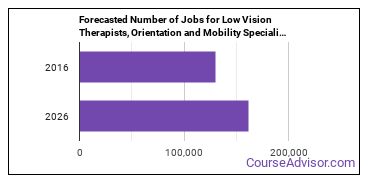
The states with the most job growth for Vision Therapist or Specialist are Utah, Arizona, and Colorado. Watch out if you plan on working in Kansas, Rhode Island, or Minnesota. These states have the worst job growth for this type of profession.
How Much Does a Vision Therapist or Specialist Make?
The typical yearly salary for Low Vision Therapists, Orientation and Mobility Specialists, and Vision Rehabilitation Therapists is somewhere between $55,490 and $120,750.
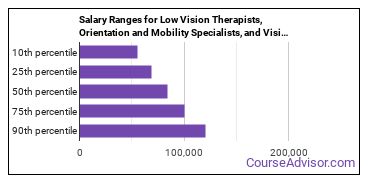
Low Vision Therapists, Orientation and Mobility Specialists, and Vision Rehabilitation Therapists who work in California, New Jersey, or Nevada, make the highest salaries.
How much do Low Vision Therapists, Orientation and Mobility Specialists, and Vision Rehabilitation Therapists make in each U.S. state?
| State | Annual Mean Salary |
|---|---|
| Alabama | $83,810 |
| Alaska | $86,860 |
| Arizona | $94,800 |
| Arkansas | $81,810 |
| California | $95,160 |
| Colorado | $89,770 |
| Connecticut | $90,780 |
| Delaware | $86,020 |
| District of Columbia | $94,360 |
| Florida | $81,520 |
| Georgia | $82,060 |
| Hawaii | $83,010 |
| Idaho | $81,230 |
| Illinois | $83,940 |
| Indiana | $79,870 |
| Iowa | $80,740 |
| Kansas | $78,720 |
| Kentucky | $79,460 |
| Louisiana | $85,490 |
| Maine | $72,160 |
| Maryland | $89,230 |
| Massachusetts | $87,160 |
| Michigan | $77,940 |
| Minnesota | $74,050 |
| Mississippi | $81,590 |
| Missouri | $75,120 |
| Montana | $74,940 |
| Nebraska | $76,850 |
| Nevada | $100,970 |
| New Hampshire | $79,850 |
| New Jersey | $96,600 |
| New Mexico | $81,660 |
| New York | $88,370 |
| North Carolina | $84,390 |
| North Dakota | $67,420 |
| Ohio | $85,720 |
| Oklahoma | $82,240 |
| Oregon | $90,720 |
| Pennsylvania | $81,030 |
| Rhode Island | $83,600 |
| South Carolina | $78,470 |
| South Dakota | $69,390 |
| Tennessee | $84,870 |
| Texas | $89,360 |
| Utah | $85,300 |
| Vermont | $76,840 |
| Virginia | $93,010 |
| Washington | $81,250 |
| West Virginia | $81,080 |
| Wisconsin | $73,390 |
| Wyoming | $82,010 |
What Tools do Low Vision Therapists, Orientation and Mobility Specialists, and Vision Rehabilitation Therapists Use?
Below is a list of the types of tools and technologies that Low Vision Therapists, Orientation and Mobility Specialists, and Vision Rehabilitation Therapists may use on a daily basis:
- Microsoft Excel
- Microsoft Word
- Microsoft Office
- Microsoft Access
- Internet browser software
How do I Become a Vision Therapist or Specialist?
Education needed to be a Low Vision Therapist, Orientation and Mobility Specialist, or Vision Rehabilitation Therapist:
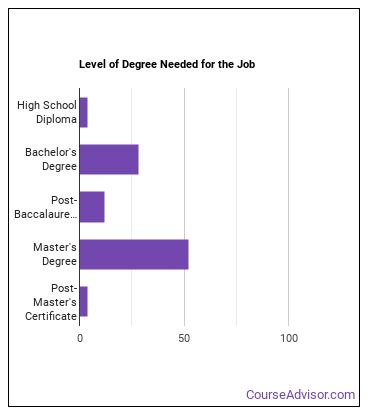
What work experience do I need to become a Vision Therapist or Specialist?
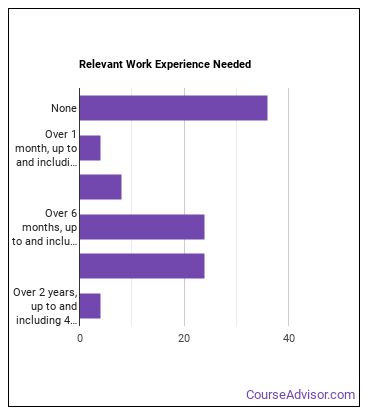
Low Vision Therapists, Orientation and Mobility Specialists, and Vision Rehabilitation Therapists Sector
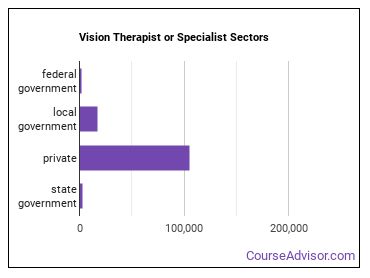
Low Vision Therapists, Orientation and Mobility Specialists, and Vision Rehabilitation Therapists work in the following industries:
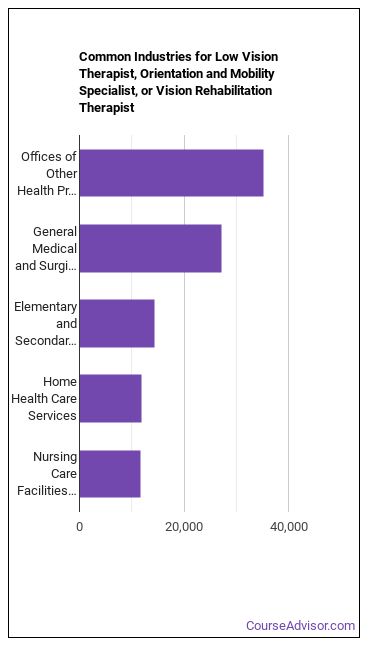
Similar Careers
Those interested in being a Low Vision Therapist, Orientation and Mobility Specialist, or Vision Rehabilitation Therapist may also be interested in:
References:
Image Credit: Barbara E. Carver via Creative Commons Attribution-Share Alike 3.0 Unported
More about our data sources and methodologies.
Featured Schools
 Request Info
Request Info
|
Southern New Hampshire University You have goals. Southern New Hampshire University can help you get there. Whether you need a bachelor's degree to get into a career or want a master's degree to move up in your current career, SNHU has an online program for you. Find your degree from over 200 online programs. Learn More > |
